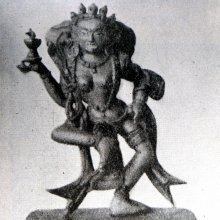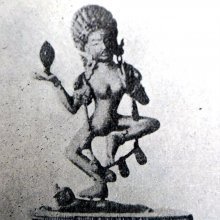Taditkara, Taḍitkarā: 1 definition
Introduction:
Taditkara means something in Buddhism, Pali. If you want to know the exact meaning, history, etymology or English translation of this term then check out the descriptions on this page. Add your comment or reference to a book if you want to contribute to this summary article.
Images (photo gallery)
In Buddhism
Tibetan Buddhism (Vajrayana or tantric Buddhism)
Source: archive.org: The Indian Buddhist IconographyTaḍitkarā (तडित्करा) refers to one of the four “Light Goddesses”, as commonly depicted in Buddhist Iconography, and mentioned in the 11th-century Niṣpannayogāvalī of Mahāpaṇḍita Abhayākara.—Her Colour is green; her Symbol is lightening; she has two arms.—The fourth and the last in the series of four goddesses of Light is called Taḍitkarā (“lightening bearer”). A statuette of this Goddess occurs in the Chinese collection under the title of Vidyuddharā. The image answers the description in all details The two are therefore identical.
Taḍitkarā is described in the Niṣpannayogāvalī (pañcaḍāka-maṇḍala ) as follows:—
“Taḍitkarā is green in colour and holds in her hands the creeper-like lightening”.
[Collectively, they are conceived as nude, and as violent in appearance with garland of skulls and severed heads. They dance on a corpse in the pratyālīḍha attitude and hold their special marks of recognition in their hands.]

Tibetan Buddhism includes schools such as Nyingma, Kadampa, Kagyu and Gelug. Their primary canon of literature is divided in two broad categories: The Kangyur, which consists of Buddha’s words, and the Tengyur, which includes commentaries from various sources. Esotericism and tantra techniques (vajrayāna) are collected indepently.
See also (Relevant definitions)
Full-text: Vidyuddhara.
Relevant text
Search found 1 books and stories containing Taditkara, Taḍitkarā; (plurals include: Taditkaras, Taḍitkarās). You can also click to the full overview containing English textual excerpts. Below are direct links for the most relevant articles:
The Indian Buddhist Iconography (by Benoytosh Bhattachacharyya)

